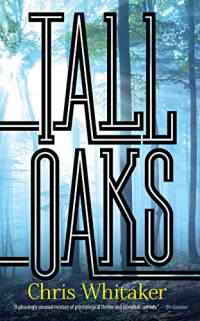Tall Oaks by Chris Whitaker
 Friday, July 19, 2019 at 7:27AM
Friday, July 19, 2019 at 7:27AM 
Published in the UK in 2016; published by Dover Publications on March 20, 2019
Tall Oaks is a place where people keep their scars hidden from view. The story’s first dramatic event, however, creates a shocking mystery for everyone to see. While Tall Oaks is both a crime novel and an ensemble domestic drama, the plot and its multiple threads are almost secondary to the carefully constructed characters.
Jessica Monroe tells Sergeant Jim Young that she saw a man wearing a clown mask on her baby monitor. When she ran to the boy’s room, the clown had disappeared with her three-year-old son Harry. Jim launches an investigation that rocks the sleepy town of Tall Oaks. He feel protective toward Jessica. She is needy and unstable, separated from her husband Michael, and losing Harry might just push her over the edge. No evidence ties Michael to the kidnapping, but the idea of a child snatcher in Tall Oaks is difficult for anyone to believe. Michael soon becomes a pariah.
A bunch of other characters are tangential to the kidnapping but play key roles in the plot. One is a teen named Manny who fancies himself to be a gangster. His mother, Elena, works hard to keep Manny under control, not that anyone takes him seriously. Manny is interested in a girl named Furat, who finds him amusing despite (or because of) his insistence on aping the language of a 1940s mobster. As a foul-mouthed kid with delusions of badness, Manny adds a dimension of comic relief to the story.
In fact, I loved Manny. He’s a liar who has a knack for telling the truth when the truth needs to be told. He’s also good to Furat, one of the few high school kids who does not regard her as a terrorist because of her national origin.
Manny doesn’t like Jared Martin, the third man his mother has dated since his father left her. Jared is plainly punishing himself. In a novel about people with secrets, the truth about Jared comes as one of Tall Oaks’ largest surprises.
Max owns a camera shop. Jerry is his developmentally disabled employee. Their interest in photography seems destined to play a role in the novel’s outcome. While Jerry is fearful and kind-hearted, he turns out to be more complex than the stereotype he initially seems to be.
Jessica’s Aunt Henrietta is married to Roger but interested in Richard because he’s a “real man.” She’s also interested in Eddie because he’s a hunk. Roger is having an affair of his own, so he might be a “real man” in his own way. Roger is from London and treats marital discord in the reserved and civilized fashion that only the British can muster. How the marriage will turn out is one of many subplots in the story.
While multiple plot threads bind the story in Tall Oaks, they all find resolutions, more or less, as the story winds down. Secrets are revealed, characters reconcile (unless they don’t), and as a mystery should, the story ends with a surprise. The plot offers many suspects for the reader’s consideration, but Chris Whitaker plays fair. The clues to the mystery are scattered through the story and the answer makes sense.
While the story is excellent, Whitaker’s ability to create memorable characters gives the novel its heart. With its delicate mix of comedy and drama, Tall Oaks is one of the most entertaining crime novels I’ve read this year.
RECOMMENDED



